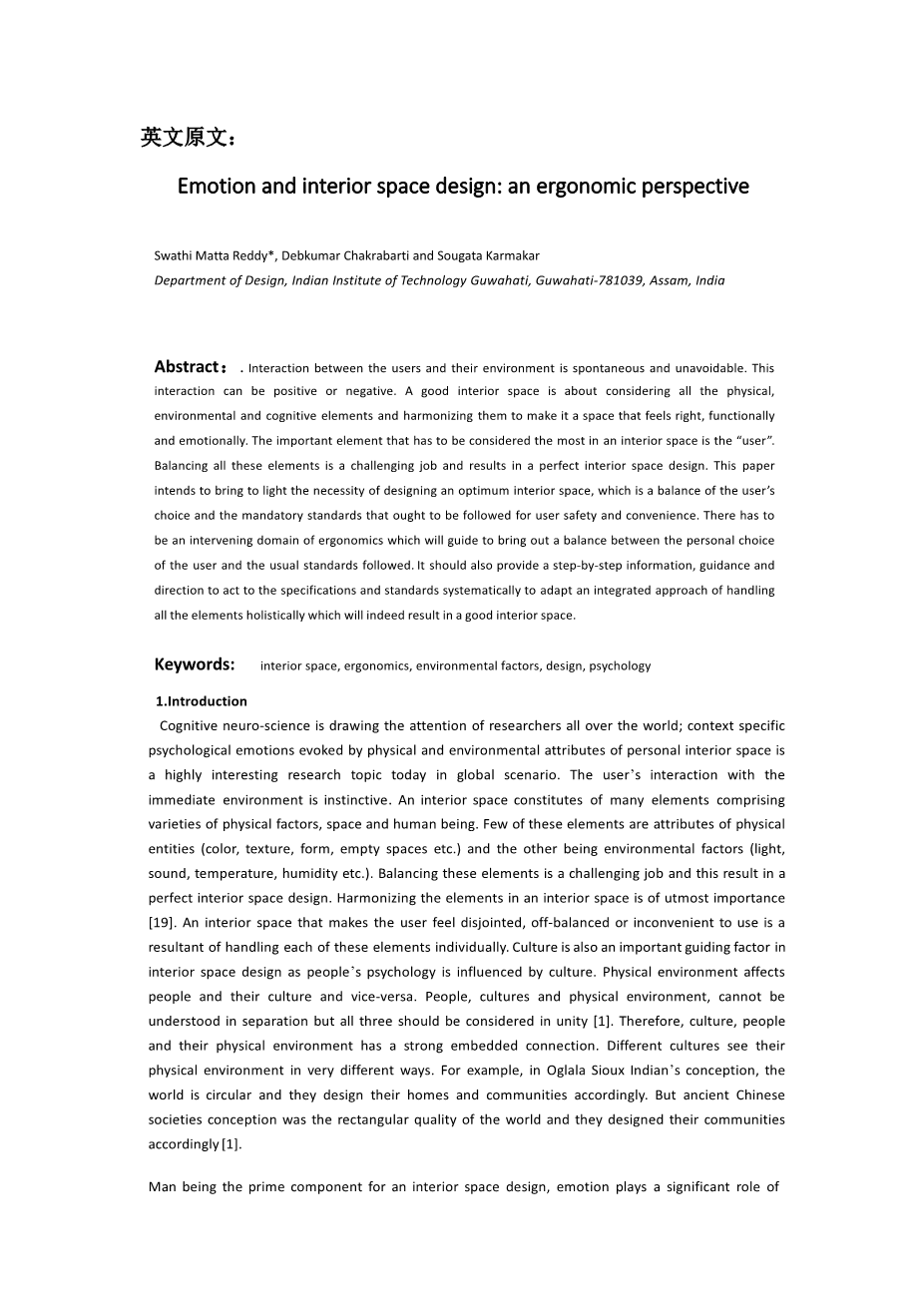Nanjing Tech University
毕业设计英文资料翻译
Translation of the English Documents for Graduation Design
英文原文:
Emotion and interior space design: an ergonomic perspective
Swathi Matta Reddy*, Debkumar Chakrabarti and Sougata Karmakar
Department of Design, Indian Institute of Technology Guwahati, Guwahati-781039, Assam, India
Abstract:. Interaction between the users and their environment is spontaneous and unavoidable. This interaction can be positive or negative. A good interior space is about considering all the physical, environmental and cognitive elements and harmonizing them to make it a space that feels right, functionally and emotionally. The important element that has to be considered the most in an interior space is the “user”. Balancing all these elements is a challenging job and results in a perfect interior space design. This paper intends to bring to light the necessity of designing an optimum interior space, which is a balance of the userrsquo;s choice and the mandatory standards that ought to be followed for user safety and convenience. There has to be an intervening domain of ergonomics which will guide to bring out a balance between the personal choice of the user and the usual standards followed. It should also provide a step-by-step information, guidance and direction to act to the specifications and standards systematically to adapt an integrated approach of handling all the elements holistically which will indeed result in a good interior space.
Keywords: interior space, ergonomics, environmental factors, design, psychology

资料编号:[245493],资料为PDF文档或Word文档,PDF文档可免费转换为Word
1.Introduction
Cognitive neuro-science is drawing the attention of researchers all over the world; context specific psychological emotions evoked by physical and environmental attributes of personal interior space is a highly interesting research topic today in global scenario. The userrsquo;s interaction with the immediate environment is instinctive. An interior space constitutes of many elements comprising varieties of physical factors, space and human being. Few of these elements are attributes of physical entities (color, texture, form, empty spaces etc.) and the other being environmental factors (light, sound, temperature, humidity etc.). Balancing these elements is a challenging job and this result in a perfect interior space design. Harmonizing the elements in an interior space is of utmost importance [19]. An interior space that makes the user feel disjointed, off-balanced or inconvenient to use is a resultant of handling each of these elements individually. Culture is also an important guiding factor in interior space design as peoplersquo;s psychology is influenced by culture. Physical environment affects people and their culture and vice-versa. People, cultures and physical environment, cannot be understood in separation but all three should be considered in unity [1]. Therefore, culture, people and their physical environment has a strong embedded connection. Different cultures see their physical environment in very different ways. For example, in Oglala Sioux Indianrsquo;s conception, the world is circular and they design their homes and communities accordingly. But ancient Chinese societies conception was the rectangular quality of the world and they designed their communities accordingly [1]. Man being the prime component for an interior space design, emotion plays a significant role of determinant in any sort of design. This emotion can be defined as complex psycho physiological experience of an individuals state of mind which can affect positively or negatively [38, 17]. A well-designed space evolves from emotion and such a space should embrace and engender the emotional support which the user aspires. The present paper deals with the importance of allindividual factors in an optimum interior space which satisfies userrsquo;s emotional need along with the standards and norms. National and international standards relevant to ergonomics of space design and behavioral psychology indicate the link between the emotional needs, comfort and user safety [48, 39]. This provides an understanding of the relation or the association between the human and the built environment. Recognition of the individual as well as group emotional choice regarding the space and its utility brings it utmost completeness. In contrary, if the choice is completely given to the users, it may lead to confliction and compromise with the technical aspects of the interior space. Different aspects in integrating all the elements of an interior space are being explored in this article. In this article focus has been made on putting forth the need of an intervening domain of ergonomics which will guide to bring out a balance between the personal choice of the user and the usual standards followed.- Physical entities in an interior space
- Color
剩余内容已隐藏,支付完成后下载完整资料

英语译文共 13 页,剩余内容已隐藏,支付完成后下载完整资料
资料编号:[245493],资料为PDF文档或Word文档,PDF文档可免费转换为Word
原文和译文剩余内容已隐藏,您需要先支付 30元 才能查看原文和译文全部内容!立即支付


